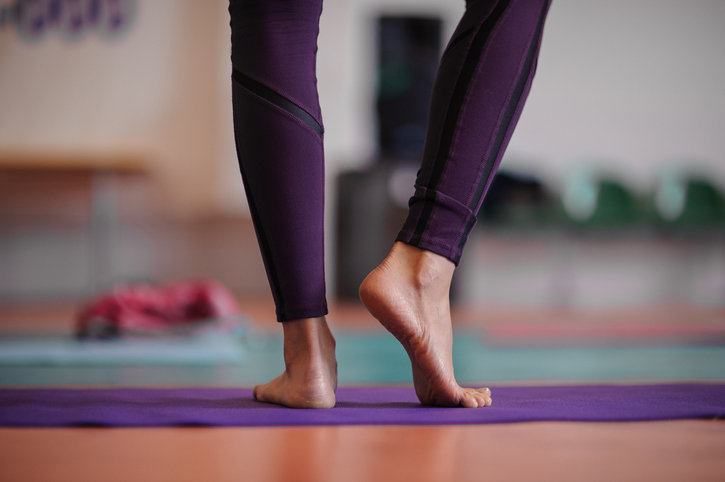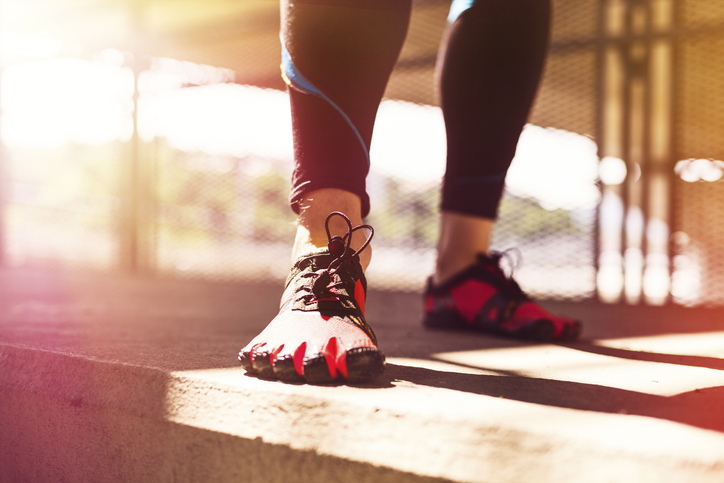A supportive pair of shoes is the first item on most lists of essential exercise equipment, so how did barefoot training become so popular? Look down and around you, and you’re bound to see people doing all types of fitness — from weightlifting to running — without shoes.
Are these athletes not wearing shoes just showing off, or are there real benefits to training barefoot? We reached out to experts to get their thoughts on the pros and cons of going shoeless so you have all the information before jumping into this trend barefoot head-first.
Is it safe to train barefoot?
Barring any environmental or health concerns, it is safe to try training barefoot. However, there are some safety factors to consider.
environment
Before throwing your kicks away, the first thing to evaluate is your environment. While some fitness studios may allow you to go barefoot or even require you to remove your shoes for certain activities, others may require athletic shoes for safety and hygiene reasons. Of course, you must follow the facility’s guidelines.
If you tend to exercise outdoors, take a look around and use your best judgment. If the floor or anything on it could cut, scratch, or burn your feet, keep your shoes on.
Medical conditions
Next, think about your feet (and the body attached to them).
“Anyone with any type of sensory loss in their feet, or people who are at higher risk of sensory loss in their extremities, such as people with diabetes, should avoid training barefoot,” he says. Jack McNamaraMSc CSCS, Lecturer in Clinical Exercise Science at the University of East London.
If you have a chronic condition that affects your gait, McNamara recommends consulting a podiatrist before trying to train barefoot. A history of injuries (especially shin splints, ankle or foot pain, and stress fractures) also warrants a conversation with your doctor.
Running experience
If you’re thinking about running barefoot, start slow. Unless you’re an experienced runner, Neeraj Vora, PT, co-founder of Stride Store In New Orleans, Louisiana, she recommends starting with a program of walking and foot-strengthening exercises before progressing to barefoot running.
“Our tendons, muscles and bones undergo changes through constant training that are crucial to withstanding the stress that running puts on our bodies,” Vora says. “If you have been running consistently for more than a year, we recommend starting with short bouts of barefoot running for 30 seconds to one minute mixed with walking.”
What are the benefits of barefoot training?

Considering how much we pay for sneakers, there better be a good reason no Wear it. Here are some potential benefits of barefoot training.
1. Greater foot movement
Some forms of exercise require restricted foot movement in shoes. If you’ve ever done an exercise like Pilates, you know that subtle changes in foot position (for example, pointing the toes or flexing the foot) can affect the intensity of the movement or completely change its focus.
And if yoga is your jam, a pair of high-heeled sneakers will only throw off your balance and slow down your sun salutations. To experience the full range of motion of your toes, feet, and ankles, you need to walk barefoot.
2. Stronger feet
The springy soles of your favorite running shoes are comfortable, but some experts think all that cushioning may be making your foot muscles weaker.
“Supportive shoes are designed to reduce the work these shoes do [foot] says Dr. Mike Rushton, DPM, co-founder and medical director of… Forward medical movement In St. George, Utah. “But, if you don’t let these muscles work properly, like anything else, they become weak and lose their ability to do their job effectively.”
This can shorten your athletic performance and ultimately lead to muscle imbalances and injuries. “Training barefoot allows your feet to function naturally, engaging a whole new group of muscles that you may not have known you had,” says Rushton.
3. Improve body awareness
Besides doing all the heavy lifting for your foot muscles, shoes also act as a barrier between the nerve endings in your feet and the surface you’re standing on. Taking your shoes off allows for a better sensory experience, which can help with proprioception, or your awareness of your body and how it moves in relation to its surrounding environment.
Being able to feel the ground beneath you may also help you achieve better form and alignment on some lifts.
“Barefoot squats can help build flexibility in the ankles and hips as the knees move back and forth, which helps to properly target the hip flexors and hamstrings,” says Jack Craig, CPT. Inside bodybuilding.
Can you do barefoot training if you have plantar fasciitis?
Plantar fasciitis occurs when the thick band of tissue that connects your heel bone to your toes becomes inflamed. It is often very painful and should be evaluated by a medical professional.
While you should listen to your doctor’s recommendations regarding physical activity, it is best to avoid training barefoot if you have plantar fasciitis.
“Walking barefoot for long periods should be avoided for people with plantar fasciitis because prolonged forceful pressure on your heel and foot on hard ground can increase pressure on your already inflamed arch and heel and can make plantar fasciitis symptoms worse,” he says. doctor. Christine Gasnick, PT, DPT.
“Plantar fasciitis has a very strong association with shoes,” says Jasnick. “So making sure you invest in the right shoes that have good shock absorption and foot support can help reduce the symptoms of plantar fasciitis and improve your ability to walk barefoot without pain once the inflammation resolves.”
Barefoot training shoes

Intrigued but not yet ready to “reveal” everything? These simple barefoot training shoes provide a barefoot training experience while providing a barrier between you and the ground.
Barefoot
Known for their wide, flat and flexible soles, Vivobarefoot offers a full range of minimalist shoes for the whole family.
Vibram five fingers
This is the closest you can get to being barefoot without actually being barefoot. Vibram FiveFinger shoes are made with ultra-lightweight materials, flexible soles, and individual toe pockets.
FeelGrounds
Ranging from trendy shoes like sandals and boots to active sneakers, FeelGrounds shoes are all about comfort, style and environmental responsibility.
Hadith
Although not marketed as a barefoot training shoe, Converse athletic shoes, specifically Chuck Taylors, are often the shoe of choice for Olympic weightlifters, thanks to their flat sole.
